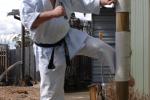Difficult Research in Developing Karate—Part 2
November 11, 2013
Personal research requires you to look inward towards your own nature, and to take responsibility for your karate; to step out of your comfort zone. You can do this by attending events like open courses if you like, but in truth, such challenges do little to aid your progress.
Difficult Research in Developing Karate—Part 1
November 4, 2013
“Karate training is easy!” Now there’s a statement to get your head around. But is there any truth to it; is training in karate easy? Well, children, the unfit, the lazy, and folks of dubious character…all seem to have no problem being awarded a black belt in karate these days, so the training must be easy…right?
Unraveling Knots in The Thread of Life
October 14, 2013
Over a period of about eight years, beginning in the early 1990s, I began taking a closer look around the world at the various religious and philosophical beliefs people held, and saw in many of them much to be admired. I also noticed there was quite a lot of common ground. I was initially astonished to discover, for example, how the sacred text of Judaism, the Torah, tells the same story as the first five books of the Bible, known to Christians as the books of the Old Testament.
Chojun Miyagi, The Typhoon Man
October 7, 2013
(The following is an excerpt from Chojun A Novel by Goran Powell. Chojun Miyagi, born in Higashimachi, Naha, Okinawa, April 25, 1888. He began studying Karate at age nine. He first learned martial arts from Ryuko Aragaki who then introduced him at age 14 to Kanryo Higashionna (Higaonna Kanryo.) He continued studying and teaching until his death from heart disease in Okinawa October 8, 1953.)
Qin Na in Chinese Martial Arts
September 16, 2013
Nobody can tell exactly when Qin Na was first used. It probably began the first time one person grabbed another with the intention of controlling him. Grabbing the opponent's limbs or weapon is one of the most basic and instinctive ways to immobilize him or control his actions.
Fundamental Sword Training and Practice
-
September 2, 2013
Jian is the king of the short weapons. Skill in the use of the Jian is built on a foundation of skill with the saber, which is called the root of the short weapons. Any martial artist who wants to master the Jian should first master the saber; otherwise it will be extremely difficult to understand the applications of the techniques and the source of the power in sword practice.
Taiji Sword and Its Applications
-
August 26, 2013
Since Taijiquan has developed for more than a thousand years, various styles have been created. There are many Taiji sword sequences in existence. All of these sequences have grown out of the same Taiji theoretical roots.
Ancient Chinese Weapons and Martial Artists
-
August 12, 2013
Chinese martial arts have evolved in China for over 5,000 years. This evolution has been experienced not only by the many schools of barehanded fighting, but also by a wide variety of weapons practitioners. As various types of weaponry have evolved, so have the materials and techniques for their fabrication.
In Search of The Real Mr. Miyagi
-
June 3, 2013
It’s ironic that the world’s best-known karate master never existed. The much-loved Mr. Miyagi from the Karate Kid movies is the product of a Hollywood scriptwriter, and just one more example of how the public’s view of martial arts has more to do with fantasy than reality.
What is Taijiquan?
-
May 20, 2013
Let us see what is Taijiquan, as it was written down in the past. First, we must define what we mean by “taiji.” It is stated in Wang, Zong-yue’s (王宗岳) Taijiquan Classic “What is taiji? It is generated from wuji and is a pivotal function of movement and stillness. It is the mother of yin and yang. When it moves, it divides. At rest it<br>reunites.”
From Whence We Came: Some Okinawa Cultural Icons
-
April 8, 2013
At a little over 26 degrees north of the equator, Okinawa enjoys a subtropical climate, and for much of the year its inhabitants live under clear blue skies. However, during the early summer months, typhoons sweep in off the Pacific Ocean bringing with them strong winds and huge seas often resulting in damage to property, and sometimes loss of life.
Taiji Ball Qigong - Theory of Physical Conditioning (強身之原理)
-
March 4, 2013
Taiji ball qigong is able to condition the physical body and change its structure from weak to strong. In addition, it can also increase the quality of endurance of the body. Due to these reasons, taiji ball qigong can be used to enhance fighting capability, and to increase the chance of survival in ancient fighting situations.
Karate-A Unique Balanced Approach to Healthy Living
-
February 26, 2013
Those who enter a dojo for the purpose of maintaining good health engage in a training routine that may look similar to those engaged in budo karate, but this similarity exists only on the surface.












